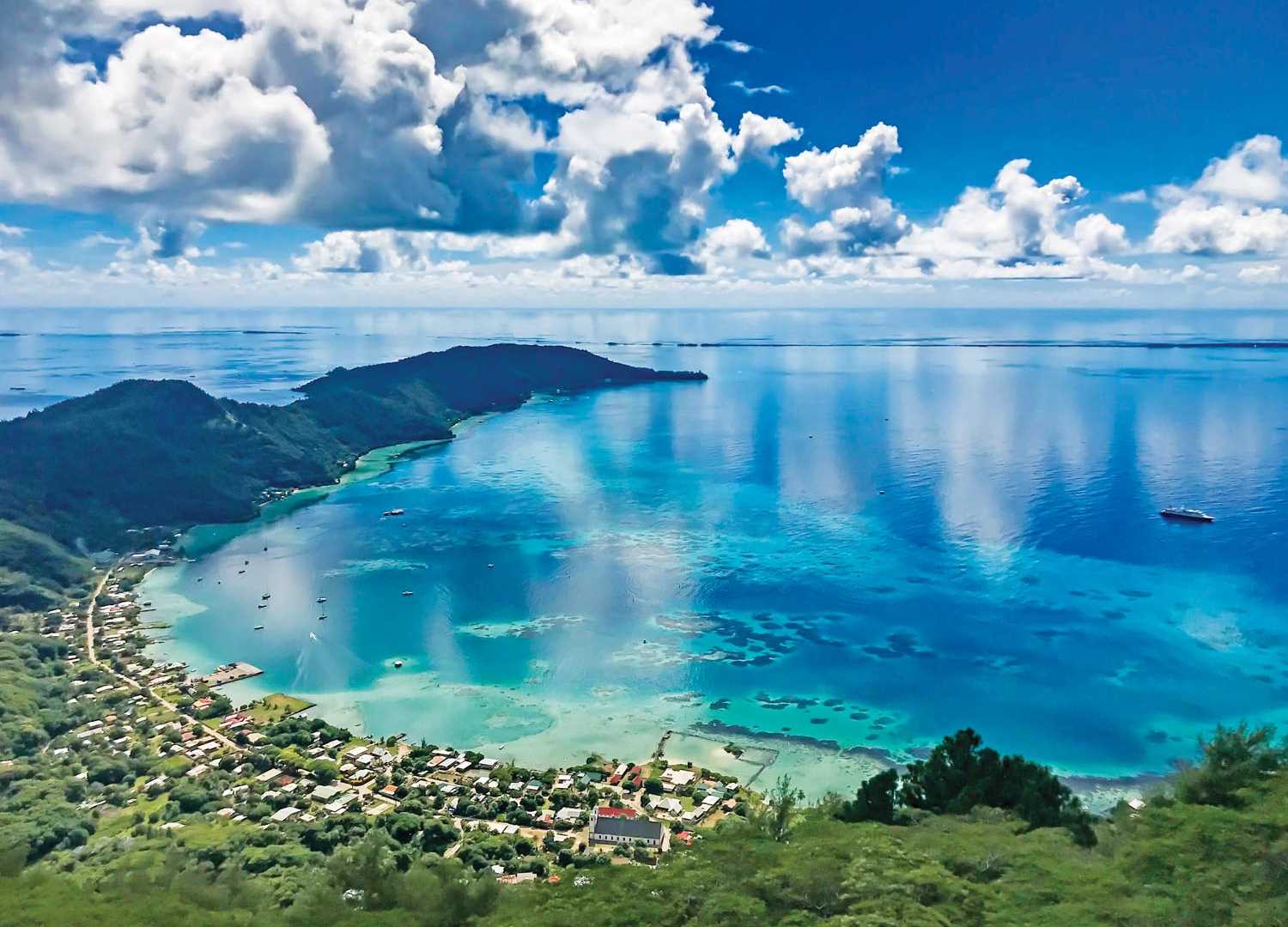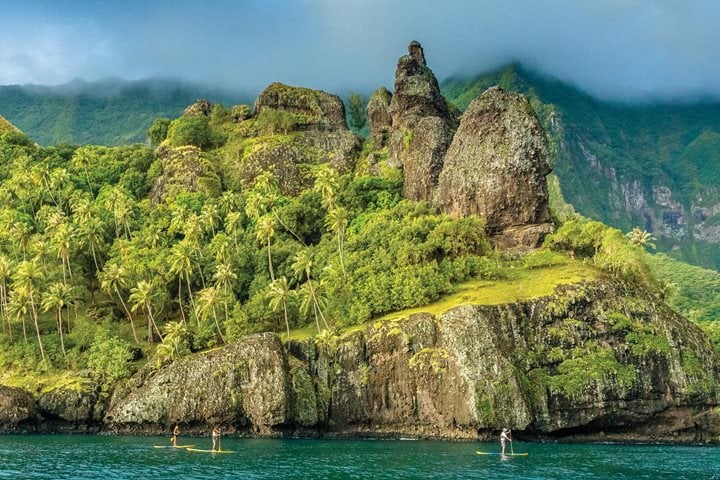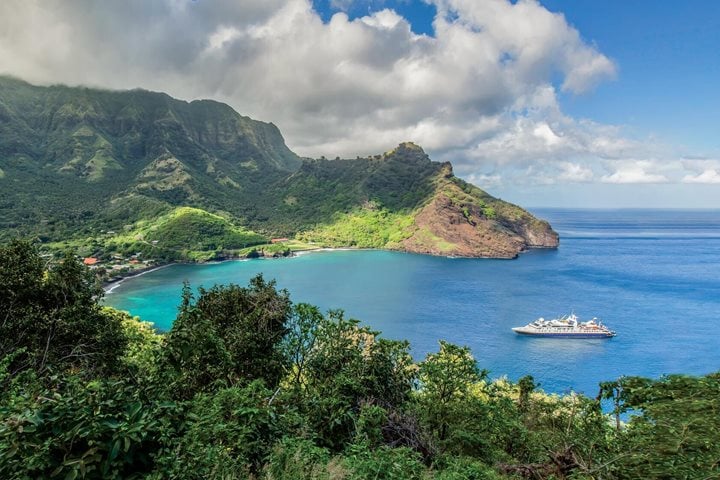Call +1.800.397.3348 or contact your travel advisor
I was lucky to meet Lars-Eric Lindblad back in 1977; he immediately hired me to be a naturalist, lecturer, boat handler, and guide aboard his famous ship Lindblad Explorer, otherwise known as the “Little Red Ship.” This was the original Expedition Passenger Vessel, a designation made up by the U.S. Coast Guard by necessity in order to categorize this exceptional ship. Lindblad has been in the business of conducting expeditions, ever since. And now, under Sven Lindblad’s guidance, a fleet of 13 ships has replaced the original "Little Red Ship". Back then, Lars-Eric Lindblad passionately wanted to bring intrepid travelers to Rapa Nui. However, he was told that with no harbors, no airstrip ready, and no accommodations, it would be next to impossible. Get Inspired By Photos, Videos, Webinars, Stories, And Exclusive Offers. Sign Up
Impossible was not an obstacle to the man who had pioneered expedition travel to Antarctica and Galapagos, so he gathered a team of experts around him to develop a compelling itinerary and devised a plan—that involved building an airstrip and creating a ‘pop-up’ Africa safari-style luxury tent city for the first group of intrepid Lindblad travelers.
I feel privileged to have been part of the vivid Lindblad history—my career of more than 40 years started in the South Pacific, and I have since managed to explore nearly all of it. This region, now easily reached by National Geographic Orion with her fleet of Zodiacs, kayaks and stand-up paddleboards aboard, plus excellent accommodations, has so much to offer expedition travelers: people, history, archeology, marine life, and exceptional natural beauty. I think of all the islands in Polynesia, Easter Island, also known as Isla de Pascua to the Chileans, and both Rapa Nui (Broad Paddle) and Te Pito Te Henua (Navel of the World) to the Polynesians, is easily the most fascinating region within the sprawling Polynesia triangle. The most isolated habitable land in the world, it is located 2,350 miles west from Chile, 1400 miles east from Pitcairn Island, the two nearest bits of land. Rapa Nui is a volcanic island roughly triangular in shape, with an extinct volcano at each corner. Although it is relatively small —14 miles east to west and 7 miles north to south – it sits atop a huge volcanic plateau some 150 miles in circumference, and is surrounded by some of the world’s deepest waters, more than 10,000 ft deep in places. Mysteries still abound here, the origins of the moai remain stubbornly unsolved, despite the work of hundreds of archeologists. And the thrill of landing on the remote and storied islands we visit aboard Orion will be as fresh for you as it was for the early Polynesian navigators, the Bounty mutineers, and the other seafarers, explorers and romantics who have ventured here over the centuries.
EASTER ISLAND
Easter Island was colonized by Polynesians probably between AD 900 and 1000, according to the latest radiocarbon dates. Over the centuries, the Islanders became cut off from trading partners and contact with the rest of Polynesia, leaving the culture to evolve in complete isolation. The design and style of the incredible megaliths, or moai, are unlike any other statues found in Polynesia, or the rest of the world, for that matter.
There are about 900 moai known to exist. The statues were carefully chipped out of relatively soft tuffstone (compacted volcanic ash) with handheld hammerstones made from much harder basalt. How many man-hours must it have taken to complete one of these behemoths? We’ll see the quarries where they were produced— and we can still only speculate on how they were transported and erected all over the island. Unfortunately, there is no written history or reliable oral traditions to describe what happened here before the coming of Europeans, which tragically resulted in the almost complete destruction of the Easter Islanders and their culture—through devastating diseases and forced enslavement for the nitrate trade in Peru. In recent decades, there has been a resurgence in all things Polynesian, and the indigenous population is now thriving. I have known some of the archaeologists we’ll meet for the many years I’ve been coming here with our guests. They have pieced together much of the island’s prehistory, and you’ll find discussing Easter Island’s secrets with them fascinating. I have not found a more interesting island in all the world, and I am certain you will agree.
PITCAIRN
Photo: Jeff Mauritzen
I thought I knew a lot about Pitcairn Island even before I ever got there—I had seen the first two movies about the infamous Mutiny on the Bounty, and had read part of Nordhoff and Hall’s trilogy so, I thought I knew what to expect. As I quickly learned when I first arrived in 1977, the island has little in common with the white sand beaches, waterfalls, lush vegetation, and calm, shallow lagoons found in Tahiti and Bora Bora where those movies were filmed. Pitcairn is a small, rugged volcanic island. The coastline is mostly steep exposed cliffs, often pounded by heavy seas, and with no protected bays or sandy beaches.
Like Easter Island to its east, Pitcairn is one of the most isolated inhabited islands in the world. We all know the story of the HMS Bounty mutiny that occurred on April 22, 1789, near Tonga. Of the 44 men aboard the Bounty, 23 actively took part in the mutiny. Of those, Fletcher Christian (the leader of the mutiny) and eight crew, along with six Tahitian men, and 12 Tahitian women settled on little-known and uninhabited Pitcairn’s Island.
When we visit, we’re reminded everywhere of the history by the place names and artifacts (there’s a marvelous little museum near the square). And examining the headstones in the graveyard I find especially interesting—one sees recognizable surnames like Christian, Warren, McCoy, Morrison, Young, etc. The isolated grave of the last surviving mutineer and undisputed patriarch of the early Pitcairn community, John Adams, is one of most important and revered historic sites on the island.
The modern-day descendants are a unique blend of European and Polynesian cultures and genetics. Although English is the official language (the island is a British Overseas Territory), the locals speak a unique language among themselves, a delightful mix of English and Polynesian words. It is great fun to interact with the Pitcairners. I have made numerous friends here over the years, although many have passed away since my earliest visits. Typical for Polynesian islanders, they are very friendly and welcoming. Our visit will be a major event in the community, because few people manage to reach their island. The meeting place for everyone is the tiny main square in the quaint village of Adamstown, and they always have plenty of items and crafts for sale. We’ll also be able to hike, explore, view the wildlife, including numerous tropical bird species, and enjoy the natural beauty at such places as Christian’s Cave and Saint Paul’s Pool. As many places as I’ve been, I consider each opportunity to land here an accomplishment on my resumé.
MANGAREVA
Imagine an archetypal South Seas lagoon, the beautiful blue, encircled by a narrow, protective band of living coral reef: that’s Mangareva. The jewel of the Gambier Islands, Mangareva is a textbook example of the ongoing slow physical transformation of a high volcanic island like Mo’orea or Bora Bora into a low, flat coral atoll typical of the Tuamotus. I first came here in the mid-1970s and was blown away by the exotic beauty of the island and the graceful, laid back feel to the main settlement of Rikitea.
However, it has a complicated history. Polynesians have inhabited the Gambier Islands since at least the 10th century. Life must have been easy early on with abundant food crops, including coconuts, breadfruit, bananas, taro, papaya, etc., and plenty of fish and shellfish in both the lagoon and just offshore. But, archaeologists have discovered a drastic reduction in the population size and a cessation of inter-island trade during the 15th or 16th_century, resulting in near total isolation from the rest of Polynesia. Then, Europeans arrived in the late 18th century. In 1834, Father Louis Honoré Laval came here and began to convert the Polynesians to Christianity. Once King Maputoea converted, Laval gained complete control over the populace, and during the next 30 years he oversaw what historians call ‘the death of a people’. He established a theocratic dictatorship, exerted control of the pearl trade, locked up the entire female population whenever whaling or trading ships arrived, and ordered the construction of St. Michael’s Cathedral. It took nine years to build and when completed, could accommodate 1,200 people. In addition, he also orchestrated construction of a palace, a monastery, a convent, a prison, a textile factory, and coastal watchtowers.
It became a city, unlike anything a Polynesian island had ever experienced. Forced labor, the loss of ancient customs, unaccustomed clothing, and European diseases are all believed to have contributed to a second devastating depopulation of the Gambier Islands. Reports of the terrible loss of life and suffering within the Gambiers eventually reached the provincial government in Papeete, an investigation ensued, and Father Laval (a.k.a. the ‘mad priest’) was recalled. His infamous response to the inquiry was “…they have but gone more quickly to heaven.” We’ll visit the recently restored cathedral, and observe the ruins of other European-style coral stone buildings. The natural history rivals the island’s vivid human history, and we’ll experience the natural magnificence: exploring the islands topography, snorkeling or diving. Plus, for those so inclined— there’s a challenging hike up to the summit of Mt. Duff for stunning lagoon views.
THE TUAMOTUS
Thinking of the Tuamotu Islands brings back wonderful memories of carefree days enjoying the typical ways of island life. The amazingly friendly, welcoming, and accommodating islanders would put on a dance at the spur of the moment, and fresh fruit was always offered. While the islanders now live in solid concrete block houses with corrugated iron roofs rather than thatched houses, and use fiberglass boats with outboard engines instead of canoes, plus motorbikes, cars, and trucks on even the most remote inhabited islands, their attitudes and lifestyles haven’t changed a bit. The Tuamotu islands are beautiful, the people who live there are beautiful, as is their culture and outlook. It really is a privilege to meet these people. The islands themselves are low, and flat—linear along the horizon, circles seen from the air—coral atolls, characterized by roughly round narrow bands of flat-topped coral reefs and low, sand-covered islands and islets encircling internal lagoons. Of course, there are variations on the theme, but the islands generally follow this same design. Whether you’ve found geology interesting in the past or not, I think you’ll find the talks on the subject here, illustrating the volcanic formation of these ancient islands and the effects of their ‘collapse’, fascinating. Many have cuts in the reefs that allow National Geographic Orion’s skilled captain to bring ship into the lagoons. On recent voyages, using Google Earth and drones, our expedition team has brought us into locations never visited by a ship—an occurrence celebrated by the residents. Less than half of the islands are inhabited, so we’ll enjoy an exhilarating mix of cultural and natural history opportunities.
As a trained archaeologist and paleontologist, I am always fascinated by the opportunities to visit ancient archaeological sites, some well-studied by archaeologists, and others untouched since prehistoric times. Birders contemplating this trip should know—there are endemic land birds on these islands, including a species with as total population of just 37. And, of course, the coral reefs and coral reef fish will be a thrilling facet of our time in the Tuamotus—with snorkeling and diving a near-daily option, as is Orion’s glass-bottom Zodiac for ‘dry’ observations! Black pearls are important to the Tuamotus economically, and we will come across islanders selling black pearls (which can also be bluish, greenish, brownish, etc.). In my opinion, black pearls are more interesting and more beautiful than typical white pearls. And I’ve learned they’re a perfect gift—surprising and appreciated!— to bring home for female friends and family expecting travel gifts.
Photo: Jeff Mauritzen
Since 1977, Tom Ritchie has led voyages to the far reaches of the globe, including Antarctica, the High Arctic, the Amazon River, Africa, New Guinea, Indonesia, Southeast Asia, Australia, and many other wild and primitive regions, as well as the South Pacific.




